MIST
Magnetosphere, Ionosphere and Solar-Terrestrial
Nuggets of MIST science, summarising recent papers from the UK MIST community in a bitesize format.
If you would like to submit a nugget, please fill in the following form: https://forms.gle/Pn3mL73kHLn4VEZ66 and we will arrange a slot for you in the schedule. Nuggets should be 100–300 words long and include a figure/animation. Please get in touch!
If you have any issues with the form, please contact This email address is being protected from spambots. You need JavaScript enabled to view it..
Characterising meso-scale ionospheric flow structures
By Gareth Chisham (British Antarctic Survey)
Measuring and understanding ionospheric plasma flow vorticity aids the study of ionospheric plasma transport processes, such as convection and turbulence, which form an important component of magnetosphere to atmosphere space weather models. This plasma flow is dominated by the large-scale convection driven by solar wind-magnetosphere-ionosphere coupling.
This study (https://doi.org/10.1029/2024JA032887) exploits a recently-developed technique that allows the removal of this large-scale component from probability density functions (PDFs) of ionospheric vorticity measured by the Super Dual Auroral Radar Network (SuperDARN). Following this removal, the residual PDFs are symmetric double-sided functions that describe the meso-scale vorticity component that derives from processes below the large scale, such as turbulence. The character of this meso-scale component varies with location in the polar ionosphere, as shown in the figure. The ability to characterise the meso-scale flows in different regions helps to improve our understanding of the meso-scale processes occurring there. Models of ionospheric plasma flow are an important component in larger-scale system models. However, at the present time, these plasma flow models only consider the large-scale convection flow. Understanding, and being able to model, meso-scale ionospheric vorticity will help improve the accuracy of these models.
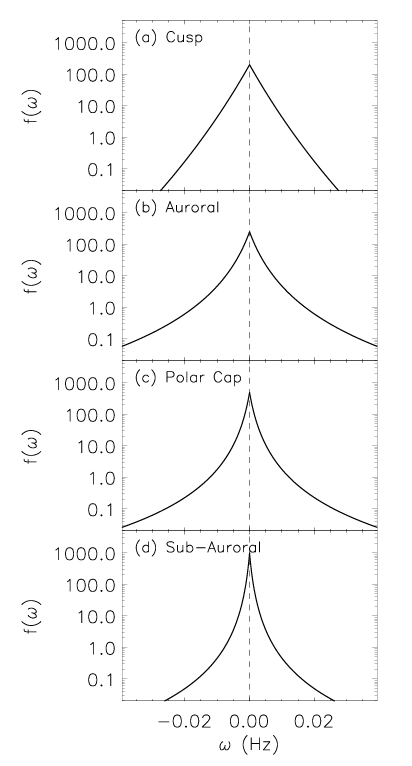
This figure presents schematic representations of the typical probability density functions (PDFs – f(ω))
of meso-scale ionospheric vorticity (ω) that are observed in different regions of the polar ionosphere:
(a) Dayside cusp; (b) Auroral region; (c) Polar cap; (d) Sub-auroral region.
Publication:
Chisham, G., and Freeman, M.P., The spatial variation of large- and meso-scale plasma flow vorticity statistics in the high-latitude ionosphere and implications for ionospheric plasma flow models. J. Geophys. Res., 129, e2024JA032887, 2024.
https://doi.org/10.1029/2024JA032887
Observation of a Fully-formed Forward–Reverse Shock Pair due to the Interaction between Two Coronal Mass Ejections at 0.5 au
By Domenico Trotta (Imperial College London)
The Sun is an active star, responsible for creating a highly dynamic and complex environment, namely the heliosphere. Solar eruptive phenomena are key consequences of such activity, which recently reached the peak of its 11-years cycle, and their study is of paramount importance to understand many unsolved mysteries of how energy is converted in space and astrophysical plasmas [1], as well as to advance our understanding of space weather, for which they are major drivers [2]. Further, novel spacecraft missions, such as Solar Orbiter [3], are opening a novel observational window into such phenomena with revolutionary measurements in the poorly explored inner heliospheric regions close to the Sun.
Solar eruptive phenomena can drive shock waves in the heliosphere (i.e., interplanetary IP shocks), which crucially can be detected in-situ, thus representing the missing link to remote observations of astrophysical systems. Sometimes IP shocks are observed in forward-reverse pairs, propagating away and towards the Sun in the local plasma frame. Forward-reverse shock pairs typically bound compressed plasma regions at solar wind Stream Interaction Regions (SIRs) between slow and fast wind originating from coronal holes [4]. Early observational evidence shows that fully formed forward-reverse shock pairs are very rare in the inner heliosphere, and more commonly observed beyond 1 AU [5]. Conversely, Coronal Mass Ejections (CMEs), the largest eruptive events from the Sun, are routinely found driving forward shocks able to accelerate particles to high energies [6]. Further, interaction between multiple CMEs has been shown as a promising pathway for fast energy conversion in the heliosphere, with a complex range of phenomena being observed in such interaction.
In our study, exploiting the in-situ Solar Orbiter instrument payload, we identified a fully formed forward-reverse shock pair at the unusually short heliocentric distance of 0.5 AU. The observation is shown in Figure 1. We found that such shock pair was not originating from a solar wind SIR, but rather from the interaction between a fast CME interacting with a preceding, slow CME, thereby creating a compression region driving the shock pair due its expansion. This enabled us to study IP shocks in highly unusual parameter regimes (for example the forward shock propagating in CME material). Further, in the interaction region between the two CMEs, a large range of interesting phenomena of energy conversion, such as enhanced rate of magnetic reconnection, has been identified.
We then used remote observations from STEREO-A to identify the two CMEs as they were ejected from the Sun, revealing that the first, slow CME was an extremely faint event. Finally, we used well the radially aligned Wind spacecraft to investigate the fate of such interesting structure, and found that it dissipated at 1 AU, where only a weak forward shock is observed, in stark contrast with SIR-driven shock pairs expected to become stronger with heliocentric distances. Thus, we highlighted how without Solar Orbiter at inner heliocentric distance, such structure would not have been possible to observe and investigate, once again underlining how exploiting multiple heliospheric vantage points is invaluable to advance our understanding of both the Sun-Earth system and remote astrophysical environments.
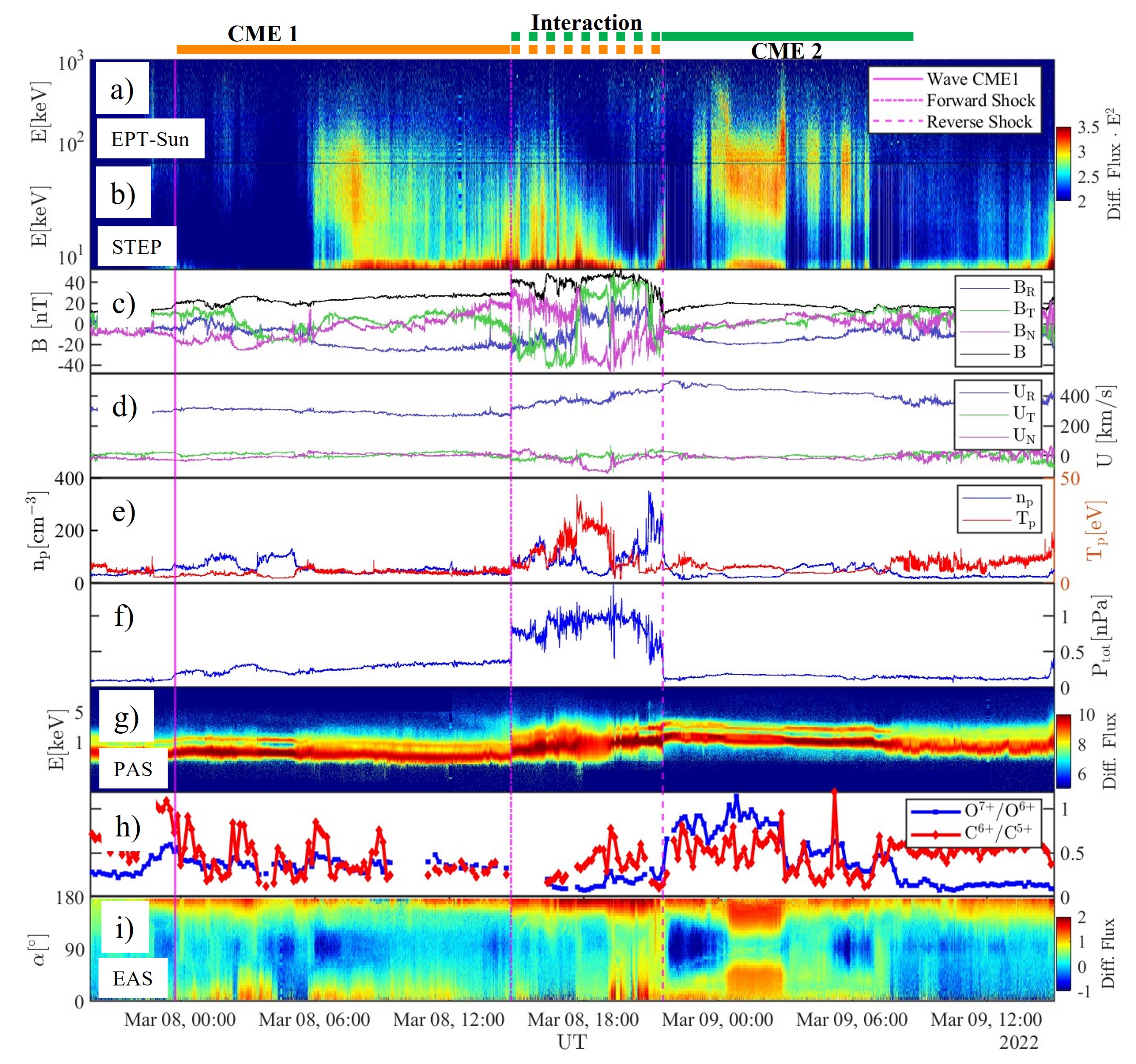
Solar Orbiter direct observation of the forward-reverse shock pair and the interacting CMEs
(full details in the publication).
References:
[1] Rice et al., JGR: Space Physics, 108, 1369 (2003)
[2] Temmer, Liv. Rev. in Sol. Phys., 18, 4 (2021)
[3] Muller et al., A&A, 642, A1 (2020)
[4] Belcher, ApJ, 168, 509 (1971)
[5] Jian et al., Sol. Physics, 239, 337 (2006)
[6] Chen, Liv. Rev. in Sol. Phys., 8, 1 (2011)
See publication for details:
Domenico Trotta et al 2024 ApJL 971 L35
DOI 10.3847/2041-8213/ad68fa
Temperature anisotropy instabilities driven by intermittent velocity shears in the solar wind
By Simon Opie (Mullard Space Science Laboratory, University College London)
Where and under what conditions the transfer of energy between electromagnetic fields and particles takes place in the solar wind remains an open question. In this paper we resolve to find a quantitative and causative link between turbulence in the solar wind and the occurrence of temperature anisotropy in the proton distribution as measured by Solar Orbiter’s Proton Alpha Sensor (PAS) which is part of the Solar Wind Analyser’s (SWA) suite of instruments. We define and derive the radial rate of strain ΓR as a dynamical measure of the driving of temperature anisotropy by bulk plasma motions. Intervals in the data unstable to the oblique firehose and mirror-mode instabilities are on average characterised by high absolute values of ΓR. We attribute this observation to the proposition that temperature anisotropies associated with these kinetic instabilities are the result of strong, intermittent velocity shears in the turbulent solar wind that cause shearing of the frozen-in magnetic field, with a local double-adiabatic impact on the particle distributions.
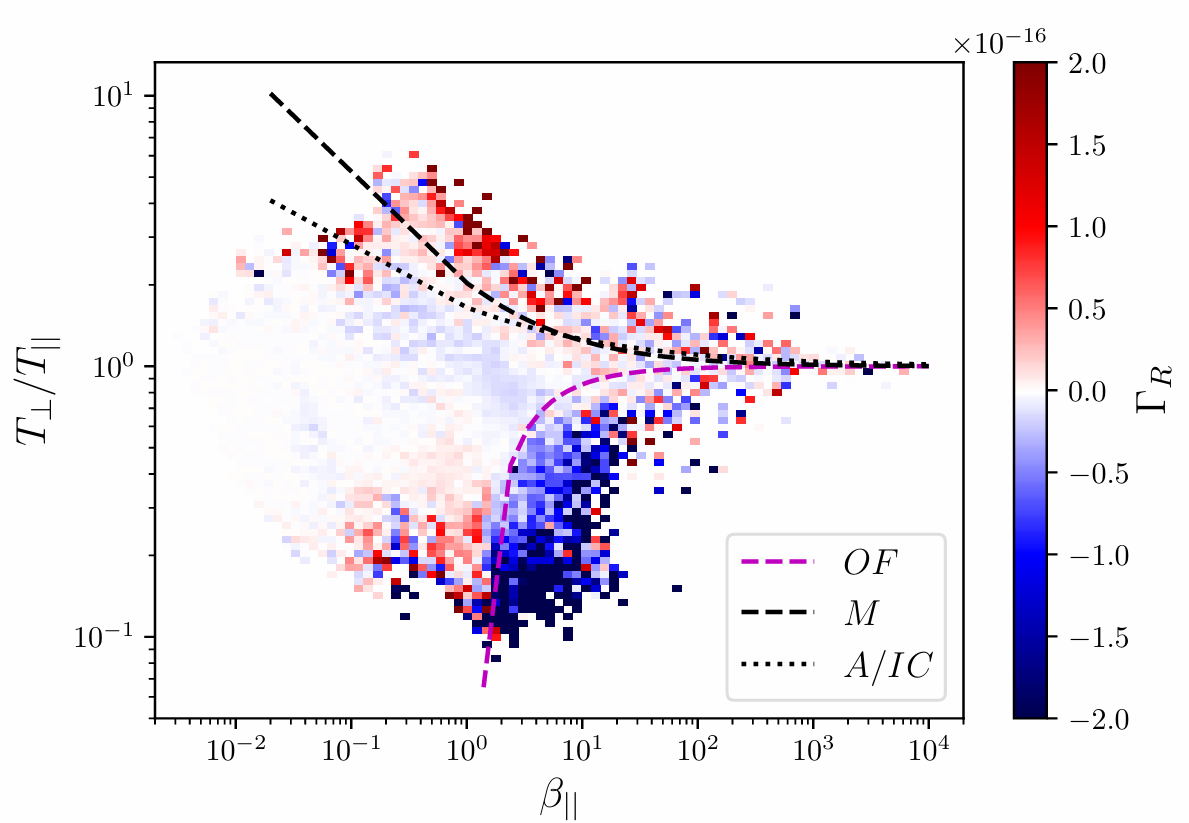
We show the distribution of ΓR as bin averages in T⊥/T∥–β∥ parameter space, where T is the temperature, β is the ratio of plasma pressure to magnetic pressure, and the subscripts represent measurement of the quantity either perpendicular (⊥) or parallel (||) to the magnetic field. We overplot the instability thresholds for the Oblique Firehose (OF), Alfvén/Ion cyclotron (A/IC), and Mirror-mode (M) instabilities. We see that the areas of parameter space beyond the thresholds for the oblique firehose and mirror-mode instabilities are well defined by extreme values in the distribution of ΓR.
See publication for details:
Opie, S., Verscharen, D., Chen, C.H.K., Owen, C.J., Isenberg, P.A., Sorriso-Valvo, L., Franci, L., Matteini, L., 2024. Temperature anisotropy instabilities driven by intermittent velocity shears in the solar wind.
https://doi.org/10.1017/s0022377824001375
Observation of Quiet-Time Mid-Latitude Joule Heating and Comparisons With the TIEGCM Simulation
By Maria-Theresia Walach & Elliot Day (Lancaster University)
Joule heating is a major energy sink in the solar wind-magnetosphere-ionosphere system and modeling it is key to understanding the impact of space weather on the neutral atmosphere. Ion drifts and neutral wind velocities are key parameters when modeling Joule heating, however there is limited validation of the modeled ion and neutral velocities at mid-latitudes. We use the Blackstone Super Dual Auroral Radar Network radar and the Michigan North American Thermosphere Ionosphere Observing Network Fabry-Perot interferometer to obtain the local nightside ion and neutral velocities at ∼40° geographic latitude during the nighttime of 16 July 2014. Despite being a geomagnetically quiet period, we observe significant sub-auroral ion flows in excess of 200 ms−1. We calculate an enhancement to the local Joule heating rate due to these ion flows and find that the neutrals impart a significant increase or decrease to the total Joule heating rate of >75% depending on their direction. As is shown in the figure. Different patches in the ionosphere move at different speeds and therefore create varying Joule heating rates. We compare our observations to outputs from the Thermosphere Ionosphere Electrodynamic General Circulation Model (TIEGCM). At such a low geomagnetic activity however, TIEGCM was not able to model significant sub-auroral ion flows and any resulting Joule heating enhancements equivalent to our observations. We found that the neutral winds were the primary contributor to the Joule heating rates modeled by TIEGCM rather than the ions as suggested by our observations. This presents a gap in TIEGCM's capabilities and care has to be taken when estimating Joule heating rates from models, which make assumptions about ionospheric flows at mid-latitudes.
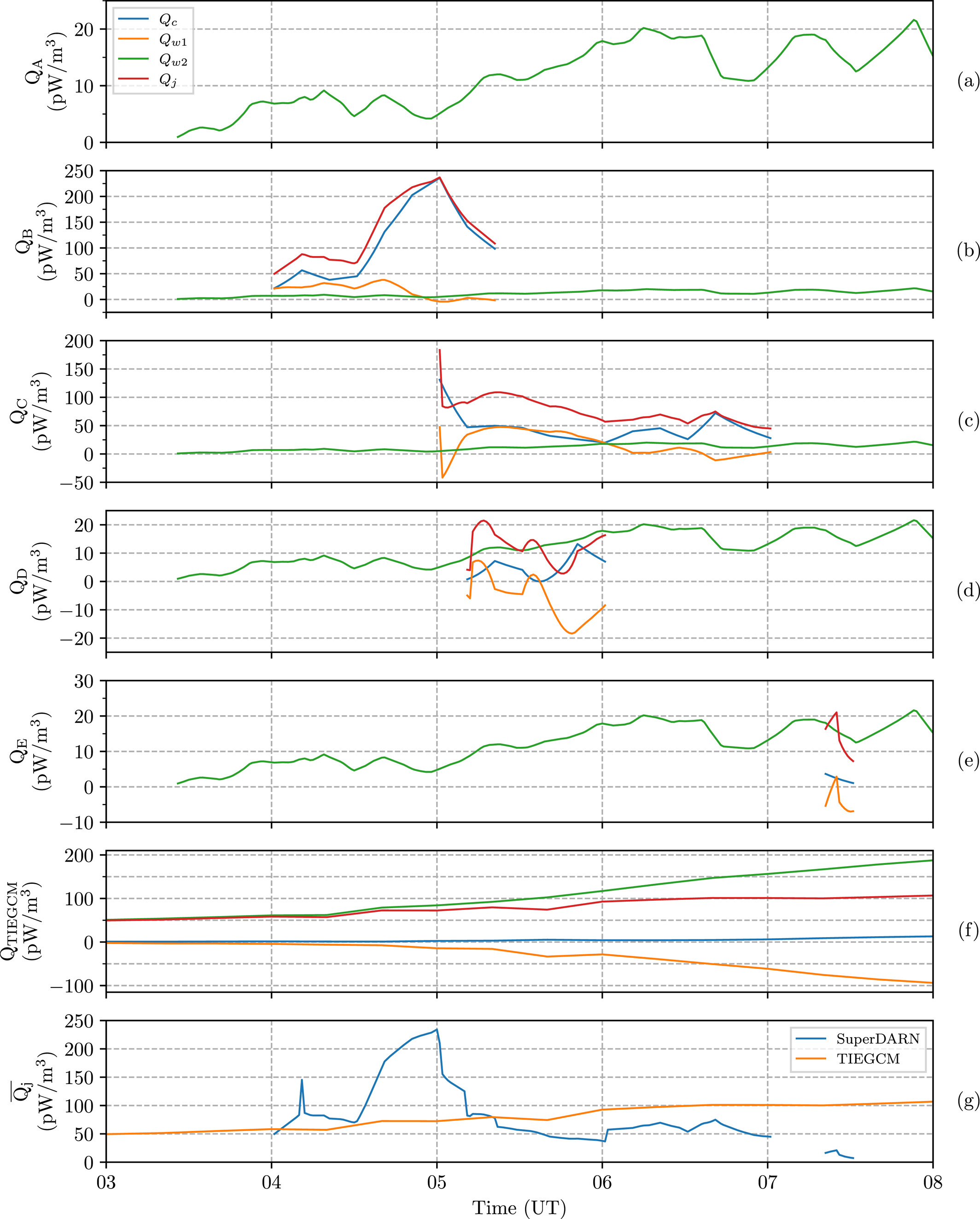
Panels a, b, c, d and e shows the estimated Joule heating components and total heating for each identified patch of
ionospheric flow, the panel labels correspond to the different patch velocities in the paper.
Each component is plotted according to the legend in panel a.
Panel f shows the Joule heating components and total heating modeled by TIEGCM.
Panel g shows the total Joule heating rate calculated as the average heating rate of all patches in the common area,
while re-plotting TIEGCM's total Joule heating in orange for comparison.
See publication for details:
Day, E. K., Grocott, A., Walach, M.-T., Wild, J. A., Lu, G., Ruohoniemi, J. M., & Coster, A. J. (2024). Observation of quiet-time mid-latitude Joule heating and comparisons with the TIEGCM simulation. Journal of Geophysical Research: Space Physics, 129, e2024JA032578. https://doi.org/10.1029/2024JA032578
On the Association of Substorm Identification Methods
By Christian Lao (UCL, Mullard Space Science Laboratory)
Substorms are a major energy unloading process in the solar wind-magnetosphere-ionosphere system that are capable of processing approximately 10^15J of stored solar wind energy through a complete cycle (Tanskanen et al., 2002). In broad terms, energy is built up and stored in the magnetosphere during substorm growth phases by enhanced reconnection between the solar wind and the magnetosphere on the dayside. Energy is released during substorm expansion and recovery phases by reconnection and other plasma instabilities in the magnetotail, with the start of the expansion phase known as substorm onset. Over the years, numerous signatures and techniques have been used to identify substorm onsets, but these are typically developed or used in isolation. In this study, we quantify the association between the different signatures used for identification of substorms (more specifically, substorm onset). Generally, we found that methods developed and applied to ground magnetometer data achieved the best associations, with events identified at mid-latitude (Chu et al., 2015) and at auroral latitudes (Newell & Gjerloev, 2011) showing the highest levels of coincidence with other substorm indicators. On the other hand, we found that events identified by particle injections (Borovsky & Yakymenko, 2017) showed much poorer associations with other substorm lists, in particular with no improvement over chance agreement with events identified from the aurora. Remarkably, we found less than 50% agreement on the timing and occurrence of substorms between any of the lists studied. As such, any studies dependent upon such lists may come to premature conclusions about substorm dynamics or impacts. Furthermore, a significant number of events in each list may not share multiple substorm signatures, calling into question the legitimacy of each identification. This highlights the need to further cross calibrate our methods or use multiple signatures to evaluate a more robust set of events.
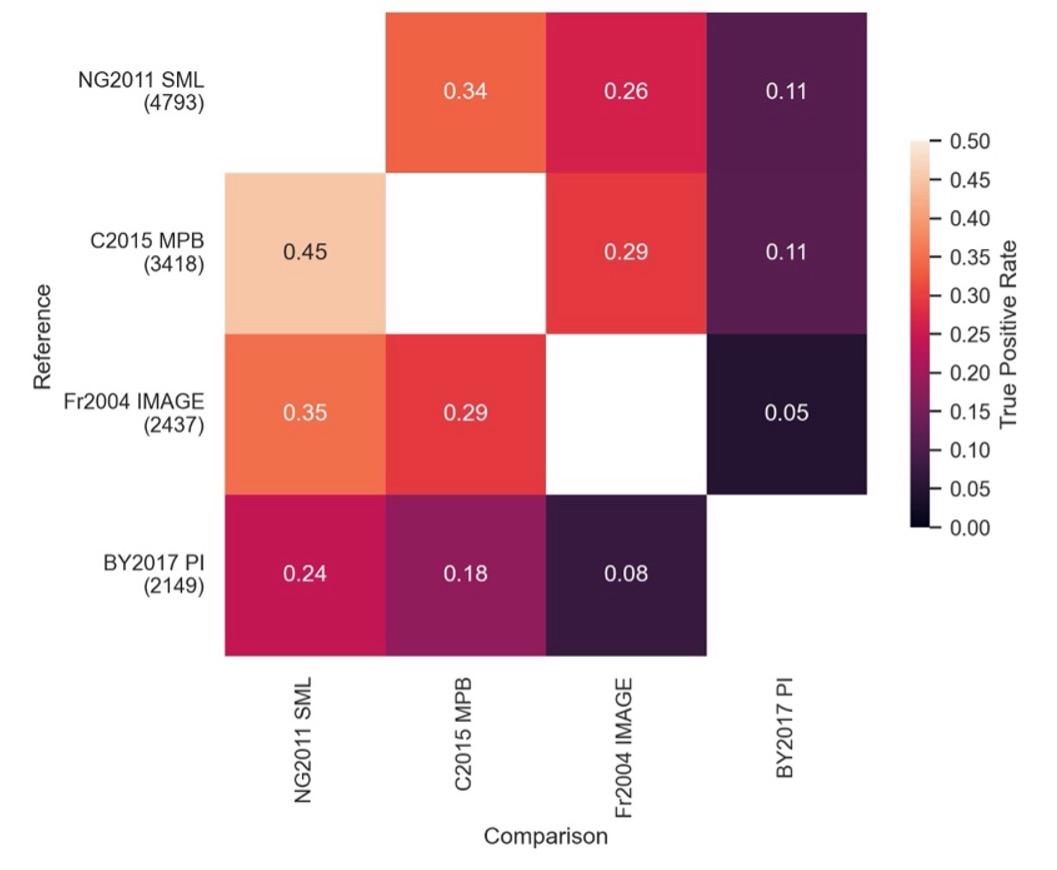
True positive rate “heatmap” showing the percentage of events from the Reference (Horizontally labelled)
substorm list a Comparison substorm list (Vertically labelled) also observes. These are the best
performing methods on the datasets they are leveraging. A higher score/lighter colour indicates better association.
References:
Tanskanen et al. 2002: https://doi.org/10.1029/2001JA900153
Chu et al., 2015: https://doi.org/10.1002/2015JA021104
Newell & Gjerloev, 2011: https://doi.org/10.1029/2011JA016779
Borovsky & Yakymenko, 2017: https://doi.org/10.1002/2016JA023625
See publication for details:
Lao, C. J., Forsyth, C., Freeman, M. P., Smith, A. W., & Mooney, M. K. (2024). On the association of substorm identification methods. Journal of Geophysical Research: Space Physics, 129, e2024JA032762. https://doi.org/10.1029/2024JA032762